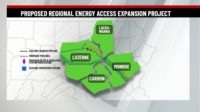After months of analysis and intense input from a broad spectrum of community and development stakeholders, New Jersey has aired implementing details of its nation-leading 2020 law to integrate “environmental justice” criteria into how, or whether, certain pollution-emitting facilities are built or expanded in communities the state has determined as “overburdened” by toxic and climate change risks.
The state Dept. of Environmental Protection unveiled the long-awaited proposed rules that will launch a 90-day public comment period as of June 6 on how it considers granting permits for facilities—including 10-MW or larger power plants, incinerators, waste recycling facilities, sewage treatment plants larger than 50 million gallons per day, landfills and other projects defined as air pollution sources under the U.S. Clean Air Act—in communities meeting minority, low-income and other population criteria.
“This is a big deal … and a watershed moment,” said DEP Commissioner Shawn LaTourette, in a June 3 briefing. “N.J. is the first state in the U.S. to wrestle meaningfully with addressing cumulative impacts of pollution that are disproportionately experienced.”
The review period will include three July hearings, with DEP aiming to enact final rules by Dec 31.
New Jersey identified 310 possibly affected municipalities that include 50% of the state population, updated with the most recent two years of census data, said Sean Moriarty, a DEP deputy commissioner.
While the number of targeted communities did not change since 2020, the agency reduced the number of environmental “stressors”—such as mobile air pollution, proximity to highways, ground-level ozone and health risks such as asthma—to 26 from 60.
DEP says it cannot estimate the cost of compliance, but notes that the rules will significantly benefit public health, and do not bar new facility construction. Also, permit approval would weigh location choice and mitigation steps, and would encourage innovation, it adds. Also key is whether a project “satisfies the compelling public-interest standard” to be built in a community on DEP’s list, although the proposal says economic benefit will not be an overriding factor.
'Stressors'
To be made available is a new digital mapping tool that can aid builders and community members to visualize how projects would impact overburdened communities, and compare impacts over different years, said Kandyce Perry, director of NJDEP’s environmental justice office. “Facilities can look at specifics and see how to reduce stressor levels,” said Moriarty. “The possibilities are endless, limited only by the creativity of the applicant.”
With stakeholders still digesting the 154-page proposal, few have advanced previous positions. Business trade groups had raised concern about compliance impacts to project costs and to future needed economic development. LaTourette noted that "folks overanticipate the impacts and suggest a parade of horribles from an economic perspective, which is completely untrue.”
Maria Lopez-Nuñez, deputy director of organizing and advocacy for an environmental group representing residents in one industrialized area of Newark, said her "initial read is that the rules adhere to the spirit of the law.” She has praised the state’s unusually broad effort to gain public input over the last year and the proposed rule’s likely impact on federal justice guidelines as well as programs in other states. “A lot of people in the EJ community are looking at this closely,” she said.
Already, large projects in set-to-be designated justice communities in the state could face added challenges.
They include a planned 84-MW methane-fueled power plant in Newark that major state wastewater utility Passaic Valley Sewerage Commission says is needed as backup for wastewater treatment management in a major storm. The agency’s main treatment plant lost power during Superstorm Sandy in 2012, sending 840 million gallons of raw sewage into the Passaic River and Newark Bay.
State approval of the $184-million project, which has faced strong community opposition, was paused in January by Gov. Phi Murphy, as the commission further studies environmental impact and added pollution mitigation technology. It said the facility may also convert from natural gas to cleaner fuels when it becomes feasible, including the use of battery power. Utility officials also promised to implement air emission controls and a hybrid microgrid.
LaTourette said the plant’s environmental justice issues could be considered now under a 2021 administrative order he issued.
Also now facing community upset—and a just-submitted petition to pause permitting—is a state plan for an estimated $4.5-billion project to widen to four lanes and replace infrastructure of a heavily traveled section of the New Jersey Turnpike built in the 1950s through Bayonne and Jersey City that links to the Holland Tunnel and into lower Manhattan.
Gannett Fleming was awarded a $30.3-million contract for preliminary design and environmental services in January.
LaTourette noted that application of the proposed environmental justice rules will be “complex and necessarily imperfect, but it’s changemaking.” He added that the rule “will be debated and refined in months and years to come,” also expecting lawsuits, “but more will meet its challenge.”
Meanwhile, other states are eyeing similar curbs, said DEP officials, pointing to efforts in Colorado, South Carolina and Michigan, although “none have the same authority we do,” said Moriarty.
A draft policy in Pennsylvania that could take effect this summer directs its state environmental agency to make environmental justice a factor in prioritizing facility inspections, enforcing compliance with pertinent laws, planning for climate-change impacts, issuing grants and funding community development projects.
In Vermont, Gov. Phil Scott on May 31 signed legislation creating that state’s first environmental justice policy.






Post a comment to this article
Report Abusive Comment